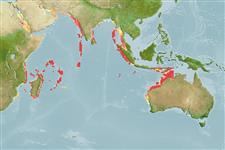>
Eupercaria/misc (Various families in series Eupercaria) >
Labridae (Wrasses) > Xyrichtyinae
Etymology: Iniistius: Latin, in = in + Greek, istion = sail; griffithsi: Named for the collector, Jeremy Griffiths..
More on author: Randall.
Environment: milieu / climate zone / depth range / distribution range
Ecologia
marinhas; intervalo de profundidade 8 - 120 m (Ref. 58466). Tropical
Indian Ocean: Mauritius, Madagascar and Christmas Island.
Tamanho / Peso / Idade
Maturity: Lm ? range ? - ? cm
Max length : 14.3 cm SL macho/indeterminado; (Ref. 58466)
Descrição suscinta
Morfologia | Morfometria
Espinhos dorsais (total): 9; Raios dorsais (total): 12; Espinhos anais 3; Raios anais : 12; Vértebras: 25. This species is characterized by the following: Dorsal rays IX,12; anal rays III,12; pectoral rays 12; lateral line interrupted, the pored scales 19-20 + 5 or 6; cheek is naked except for a curved oblique row of 6 small scales from behind to below eye; 1 or 2 small scales dorsoanteriorly on the opercle; gill rakers 19-20; body depth 2.5-2.6 in SL; dorsal profile of snout nearly vertical; first two dorsal spines slender and flexible, the first slightly longer, 2.45-2.55 in head length; space between second and third dorsal spines more than twice that between first and second spines; color when fresh, pale grey, scale edges dorsally on body grey-brown; head grey-brown, operculum suffused with orange, with vertical blue bands; a broad oblique pale blue band containing numerous small black spots
from interorbital space to above opercle; one to several black spots, edged in pale blue, on side of body above tip of pectoral fin; a dusky streak below posterior end of maxilla and lower lip; orangish patch on side of caudal peduncle, each scale with a pale blue spot; median fins bluish grey; pectoral fins orange (Ref. 58466).
Found on sandy bottoms and dives into sand to sleep safely at night or to hide when alarmed (Ref. 90102).
Ciclo de vida ou comportamento de acasalamento
Maturidade | Reprodução | Desova | Ovos | Fecundidade | Larvas
Distinct pairing during breeding (Ref. 205).
Randall, J.E., 2007. Iniistius griffithsi, a new razorfish (Perciformes: Labridae) from Mauritius. Smithiana Bull. 7:9-13. (Ref. 58466)
Status na Lista Vermelha da UICN (Ref. 130435)
Ameaça para os humanos
Harmless
Uso pelos humanos
Mais informação
Idade/TamanhoCrescimentoPeso-comprimentoComprimento-comprimentoFrequências de comprimentoMorfometriaMorfologiaLarvasDinâmica larvalRecrutamentoAbundânciaBRUVS
ReferênciasAquaculturaPerfil para aquaculturaEstirpesGenéticaElectrophoresesHereditariedadeDoençasProcessamentoNutrientsConversão de massa
ColaboradoresFotosStamps, Coins Misc.SonsCiguateraVelocidadeTipo de nataçãoÁrea branquialOtólitosCérebrosVisão
Ferramentas
Relatórios especiais
Baixar XML
Fontes da internet
Estimates based on models
Preferred temperature (Ref.
123201): 24.7 - 28.7, mean 27.2 °C (based on 108 cells).
Índice de diversidade filogenética (Ref.
82804): PD
50 = 0.5000 [Uniqueness, from 0.5 = low to 2.0 = high].
Bayesian length-weight: a=0.01023 (0.00397 - 0.02640), b=3.06 (2.84 - 3.28), in cm total length, based on LWR estimates for this (Sub)family-body shape (Ref.
93245).
Nível Trófico (Ref.
69278): 3.4 ±0.5 se; based on size and trophs of closest relatives
Resiliência (Ref.
120179): Elevada, tempo mínimo de duplicação da população menor que 15 meses (Preliminary K or Fecundity.).
Fishing Vulnerability (Ref.
59153): Low vulnerability (10 of 100).
